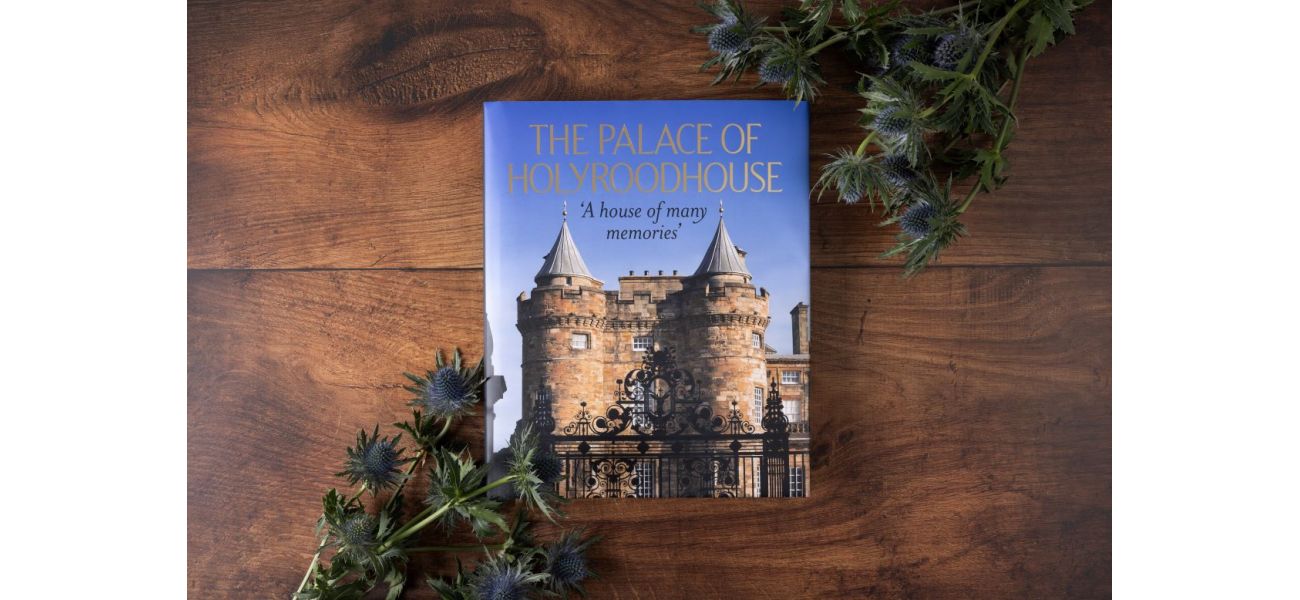New book uncovers the fascinating history of Palace of Holyroodhouse for the first time.
The Palace of Holyroodhouse has a rich history, from its origins as a 12th-century abbey to its current role as the official Scottish residence of the king, with tales of royalty, glamour, and even murder. Mary, Queen of Scots spent a short but eventful time there in the 1560s.
October 10th 2024.

If these walls could talk, they would surely have countless tales to tell about The Palace of Holyroodhouse. From its humble beginnings as a 12th-century abbey to its current status as the official Scottish residence of His Majesty The King, this grand building has seen it all – from royalty and glamour to even murder.
One of the most notable figures to have resided at the Palace was Mary, Queen of Scots. Although she only spent six years there in the 1560s, it was the site of many important events during her reign, including two of her three marriages and the gruesome murder of her secretary, David Rizzio, who was stabbed over 50 times by her jealous husband and other nobles.
In 1745, the Palace played host to Bonnie Prince Charlie during the final Jacobite rising. The lavish balls that he held there were said to have inspired renowned writers and artists such as Sir Walter Scott and Sir John Pettie. Now, for the first time ever, the Palace's dramatic past has been revealed in the official history published by Royal Collection Trust.
This comprehensive book, titled "The Palace of Holyroodhouse: A House of Many Memories," is a result of extensive research and is filled with historical drawings, watercolors, and photographs. It also sheds light on some of the Palace's more surprising residents throughout the centuries – from a Russian princess and a penniless French king to a menagerie of lions and tigers.
The origins of the Palace can be traced back to the foundation of Holyrood Abbey in 1128. In 1503, King James IV converted the royal lodgings into a palace, which was further expanded by his successor, King James V. Unfortunately, only the north-west tower from this early building remains, as the Abbey fell into ruin in the 1760s.
However, with the help of new research and GPS surveys, a reconstruction drawing of James V's lost Renaissance palace and Holyrood Abbey has been included in the book for the first time, giving readers an idea of what the Palace may have looked like in its early days.
One of the most fascinating discoveries made during the research for the book was a letter written by the Duke of Perth in 1745, confirming the occurrence of a "great ball" at the Palace just two days after the Battle of Prestonpans. This ball was likely held to celebrate the Jacobite victory and is the only contemporary reference to a specific ball known to exist.
The book also delves into the Palace's role in hosting foreign royalty in the 18th century. For instance, the Russian princess Ekaterina Romanovna Dashkova, a close friend of Catherine the Great, lived at Holyroodhouse between 1776 and 1779 while her son was being educated in the city. She became a prominent figure in society, hosting weekly dances and referring to her time at the Palace as the "happiest and most peaceful" of her life.
During the French Revolution, the Palace was home to Marie Antoinette's exiled brother-in-law, the Comte d'Artois, for seven years. He took advantage of the Abbey's status as a debtor's sanctuary to avoid his creditors and was soon joined by his sons and mistress. After the restoration of the French monarchy, he returned to Holyroodhouse for two more years before eventually becoming King Charles X.
In 1822, Holyroodhouse welcomed its first reigning monarch in almost 200 years – King George IV. The book recounts the elaborate preparations made by the visit's organizer, Sir Walter Scott, including the demolition of an entire building to make way for the King's procession up the Royal Mile. It also includes instructions for attendees, such as ladies wearing "at least nine feathers" in their headdresses and practicing the skill of moving their trains quietly and neatly after meeting the King.
Queen Victoria and Prince Albert were particularly fond of Holyroodhouse and would stay there each year on their way to Balmoral Castle. They were captivated by the beauty of Holyrood Abbey and even made sketches of the ruined building from their windows. After Prince Albert's death, Queen Victoria commissioned watercolors of their apartments to commemorate their happy times at the Palace.
The book also delves into the Palace's gardens and their various uses throughout the centuries – from medieval jousting grounds and a royal menagerie to the foundation of one of Britain's earliest botanic gardens, which later became the Royal Botanic Garden Edinburgh.
Bringing the story up to the present day, the book explores the Palace's role in the 20th and 21st centuries – from hosting its first garden party to surviving wartime bombing and opening The Queen's Gallery in 2002. It also recounts the moment when all eyes were on the Palace in 2022, as it served as the resting place for Queen Elizabeth II after her death at Balmoral Castle.
"The Palace of Holyroodhouse: A House of Many Memories" is now available for readers to explore the fascinating history of this iconic royal residence.
One of the most notable figures to have resided at the Palace was Mary, Queen of Scots. Although she only spent six years there in the 1560s, it was the site of many important events during her reign, including two of her three marriages and the gruesome murder of her secretary, David Rizzio, who was stabbed over 50 times by her jealous husband and other nobles.
In 1745, the Palace played host to Bonnie Prince Charlie during the final Jacobite rising. The lavish balls that he held there were said to have inspired renowned writers and artists such as Sir Walter Scott and Sir John Pettie. Now, for the first time ever, the Palace's dramatic past has been revealed in the official history published by Royal Collection Trust.
This comprehensive book, titled "The Palace of Holyroodhouse: A House of Many Memories," is a result of extensive research and is filled with historical drawings, watercolors, and photographs. It also sheds light on some of the Palace's more surprising residents throughout the centuries – from a Russian princess and a penniless French king to a menagerie of lions and tigers.
The origins of the Palace can be traced back to the foundation of Holyrood Abbey in 1128. In 1503, King James IV converted the royal lodgings into a palace, which was further expanded by his successor, King James V. Unfortunately, only the north-west tower from this early building remains, as the Abbey fell into ruin in the 1760s.
However, with the help of new research and GPS surveys, a reconstruction drawing of James V's lost Renaissance palace and Holyrood Abbey has been included in the book for the first time, giving readers an idea of what the Palace may have looked like in its early days.
One of the most fascinating discoveries made during the research for the book was a letter written by the Duke of Perth in 1745, confirming the occurrence of a "great ball" at the Palace just two days after the Battle of Prestonpans. This ball was likely held to celebrate the Jacobite victory and is the only contemporary reference to a specific ball known to exist.
The book also delves into the Palace's role in hosting foreign royalty in the 18th century. For instance, the Russian princess Ekaterina Romanovna Dashkova, a close friend of Catherine the Great, lived at Holyroodhouse between 1776 and 1779 while her son was being educated in the city. She became a prominent figure in society, hosting weekly dances and referring to her time at the Palace as the "happiest and most peaceful" of her life.
During the French Revolution, the Palace was home to Marie Antoinette's exiled brother-in-law, the Comte d'Artois, for seven years. He took advantage of the Abbey's status as a debtor's sanctuary to avoid his creditors and was soon joined by his sons and mistress. After the restoration of the French monarchy, he returned to Holyroodhouse for two more years before eventually becoming King Charles X.
In 1822, Holyroodhouse welcomed its first reigning monarch in almost 200 years – King George IV. The book recounts the elaborate preparations made by the visit's organizer, Sir Walter Scott, including the demolition of an entire building to make way for the King's procession up the Royal Mile. It also includes instructions for attendees, such as ladies wearing "at least nine feathers" in their headdresses and practicing the skill of moving their trains quietly and neatly after meeting the King.
Queen Victoria and Prince Albert were particularly fond of Holyroodhouse and would stay there each year on their way to Balmoral Castle. They were captivated by the beauty of Holyrood Abbey and even made sketches of the ruined building from their windows. After Prince Albert's death, Queen Victoria commissioned watercolors of their apartments to commemorate their happy times at the Palace.
The book also delves into the Palace's gardens and their various uses throughout the centuries – from medieval jousting grounds and a royal menagerie to the foundation of one of Britain's earliest botanic gardens, which later became the Royal Botanic Garden Edinburgh.
Bringing the story up to the present day, the book explores the Palace's role in the 20th and 21st centuries – from hosting its first garden party to surviving wartime bombing and opening The Queen's Gallery in 2002. It also recounts the moment when all eyes were on the Palace in 2022, as it served as the resting place for Queen Elizabeth II after her death at Balmoral Castle.
"The Palace of Holyroodhouse: A House of Many Memories" is now available for readers to explore the fascinating history of this iconic royal residence.
[This article has been trending online recently and has been generated with AI. Your feed is customized.]
[Generative AI is experimental.]
0
0
Submit Comment





